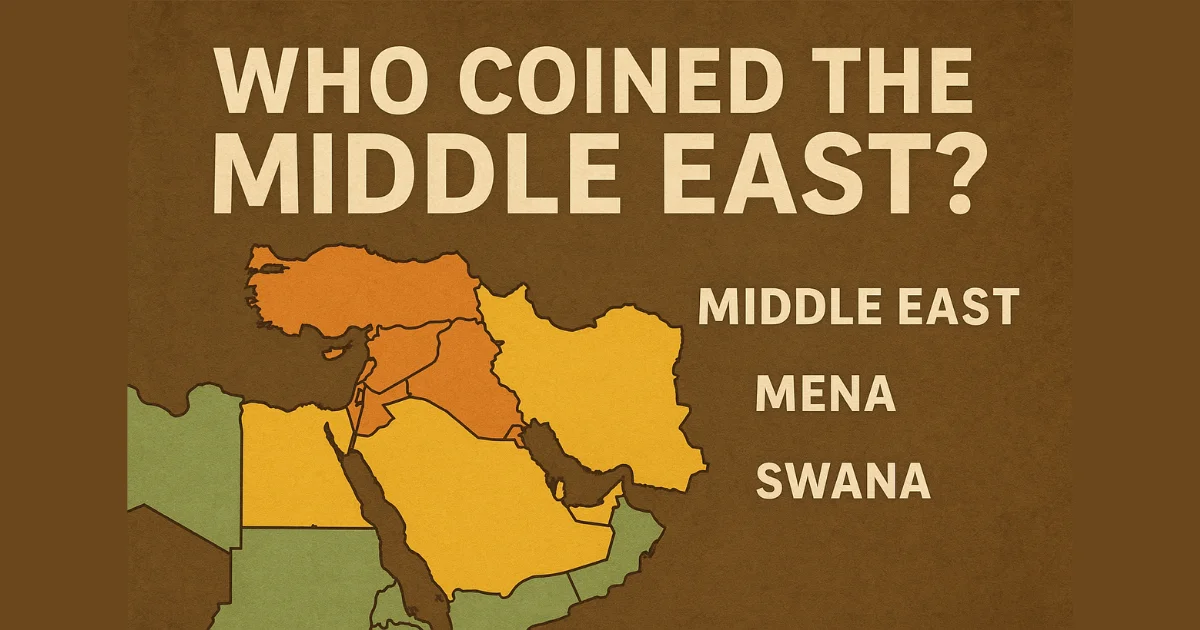The phrase “the Middle East” feels familiar: it’s used in headlines, classrooms, flight routes, business reports and diplomatic briefs. Yet it’s surprisingly slippery. Who invented it? Which countries does it actually include? And — perhaps most importantly — is the label useful, accurate or fair? This article traces the term’s origins, shows how its map has shifted with politics and purpose, lists the commonly included and contested countries, and argues what more precise and less Eurocentric alternatives make sense today.
1. The name: a product of empires and strategy
The words “Near East,” “Middle East,” and “Far East” grew out of a European — particularly British — way of orienting the non-European world into bands of distance and strategic importance. In the 19th century, British government and scholarship used the “Near East” to mean the Ottoman lands and the Balkans; the “Far East” was East, South and Southeast Asia; and somewhere in between (variously defined) sat the “Middle East.” The use of these names reflected more than geography — they were geopolitical shortcuts for imperial planners, diplomats, and strategists who wanted to map power, lines of communication, and strategic choke points.
If you want a single moment to point at for the first printed use of “Middle East” in a modern strategic sense, a widely cited instance appears in September 1902. In an article in the British monthly National Review titled “The Persian Gulf and International Relations,” American naval strategist Captain Alfred Thayer Mahan used (and later acknowledged popularizing) the expression to designate the region between Arabia and India — especially the Persian Gulf — as a zone of strategic importance for naval power and imperial communications. Mahan’s concern was very specific: control of the Suez Canal and the Persian Gulf mattered to Britain because they were routes to India, the crown jewel of imperial strategy.
Two points matter here. First, “coined” in this context does not mean Mahan invented the idea of the region — British officials and writers had been describing overlapping spaces for decades — but he did help popularize and fix the phrase in strategic conversation. Second, the term’s original purpose was strategic and Eurocentric: it was a Western shorthand about routes, empires and security, not a locally meaningful geographical identity.
2. How the map grew: from a narrow strategic pocket to a broad and fuzzy region
Mahan’s “Middle East” was relatively small — essentially the Persian Gulf and its approaches. But 20th-century events stretched and blurred that footprint:
- World War I and the collapse of empires (Ottoman, Persian and colonial rearrangements) made the region a site of major international politics, drawing in European and American definitions.
- Oil discovery and extraction, from Iran to the Arabian Peninsula and later North Africa, gave the area huge economic and strategic importance.
- Cold War rivalry and U.S. policy-making created practical reasons to group many disparate states as one region for diplomatic and military planning. The Eisenhower Doctrine, for example, framed U.S. policy with a Middle East focus in the 1950s.
The result: different actors — governments, academic institutions, media outlets and NGOs — began to draw different boundaries depending on their needs. Some lists were short (Arab core + Iran + Palestine + Turkey + maybe Egypt), others stretched from Morocco to Pakistan under acronyms like MENA (Middle East and North Africa) or Greater Middle East. The variability is why there is no single, official roster of Middle Eastern countries; definitions are purpose-driven.
3. Who is “in” the Middle East? Core lists and common variations
Because the term is pragmatic, the most useful way to approach “who’s in” is to identify the core countries usually included, then the frequently included ones, and finally the contested or peripheral ones.
Core (commonly included by most sources)
These countries form the usual nucleus of the Middle East in most atlases and policy work:
- Saudi Arabia
- Iran
- Iraq
- Palestine
- Jordan
- Lebanon
- Syria
- Kuwait
- United Arab Emirates
- Qatar
- Bahrain
- Oman
- Yemen
- Egypt (often included because of Sinai and historical-political ties)
These appear consistently in Britannica and many institutional definitions.
Frequently included (often in MENA lists)
- Libya, Tunisia, Algeria, Morocco — when “North Africa” is explicitly grouped with the Middle East under MENA.
- Palestine / Palestinian territories — politically and geographically part of the Levant grouping.
- Turkey — sometimes grouped as “part of the Middle East” because of southeastern Anatolia and political ties; sometimes categorized as transcontinental or Europe/Asia depending on the purpose.
Contested or peripheral
These states are sometimes included for historical, cultural, or economic reasons — and sometimes not:
- Sudan — sometimes included in older or broader diplomatic definitions (e.g., earlier U.S. State Department lists).
- Cyprus, Georgia, Armenia, Azerbaijan — occasionally folded in by broader “Greater Middle East” concepts or strategic frameworks.
- Afghanistan and Pakistan — sometimes in “Greater Middle East” or “Menap/Menasa” (Middle East, North Africa, South Asia) groupings; more often placed in South or Central Asia.
A good rule of thumb: if a list includes North Africa (Algeria–Morocco–Tunisia–Libya), it’s using MENA logic. If it stretches to Afghanistan or Pakistan, it’s using a “Greater” or functional grouping rather than a purely geographical one.
4. Why definitions differ: purpose, politics and convenience
Different actors draw the map to answer different problems:
- Military planners group states to streamline basing, logistics and threat assessment.
- Energy companies cluster oil-exporting states together for market and pipeline analyses.
- Scholars carve regions by cultural, linguistic or historical criteria (e.g., the Levant vs. the Gulf).
- Media and marketers use flexible groupings for audience segmentation (e.g., MENA as a TV/broadcast region).
Because the term can be molded to administrative needs, it became a catch-all for a huge swath of Eurasia–Africa that share some historical ties (Islamic history, Ottoman legacies, Arab culture in many countries) and modern economic networks (oil, trade). But the catch-all nature is precisely why the label often obscures more than it illuminates.
5. Problems with the phrase “Middle East”
A growing chorus of historians, regional scholars and activists criticize the term for several reasons:
- Eurocentric origin — “Middle” relative to European centers (Near = close to Europe; Far = distant). It centers Europe, not the region itself. This is a core critique: the label is anchored in an external viewpoint rather than any local geography or identity.
- Ambiguity and fuzziness — the label’s flexibility makes it analytically slippery. Researchers may be grouping states with very different histories, governance systems and geographies under one heading, which can produce misleading generalizations.
- Political baggage — colonial planning, Cold War policies, and modern security doctrines have used the label instrumentally; sometimes the designation carries the assumptions of past interventions and stereotypes.
- Cultural and ethnic diversity ignored — lumping Arabs, Persians, Kurds, Turks, Jews, Berbers, Copts, and a host of other groups under a single banner masks rich internal diversity.
Because of these drawbacks, alternative names have been proposed and sometimes adopted in academic and activist circles.
6. Alternatives: what should the countries be called?
There is no single perfect name. But there are three main, less Eurocentric and more geographically honest alternatives that have traction:
- West Asia (or Southwest Asia)
This name places the region within the continent of Asia — matching how many locals and regional scholars prefer to situate themselves. It makes clear the region’s relation to Asia instead of defining it by its distance from Europe. West Asia corresponds well to the “core” countries listed earlier (Levant, Arabian Peninsula, Iran, Turkey sometimes). The UN uses “Western Asia” as a statistical region.
- SWANA / WANA / SWANA (Southwest Asia and North Africa / West Asia and North Africa)
These acronyms explicitly separate West Asia from North Africa, recognizing the two distinct but historically intertwined subregions. They have appeared in academic and community advocacy contexts (e.g., SWANA used by diasporic advocacy groups). This reduces ambiguity: if you mean Maghreb countries plus Levant plus Arabian Peninsula, call it SWANA.
- MENA (Middle East and North Africa) — pragmatic but imperfect
MENA is widely used in business, media, and some scholarly contexts because it’s a convenient marketing and administrative label. It has the advantage of being instantly recognized across industries. But it inherits the “Middle” problem and can sweep over important differences between North African and West Asian states. Use MENA if your audience expects it (e.g., market reports) — but specify: are you analyzing energy markets, social movements, or climate impacts? Precision matters.
Guiding principle
Use the most geographically accurate and specific label for your purpose. If your work is about oil flows in the Persian Gulf, say “the Persian Gulf states” or “Gulf Cooperation Council (GCC) countries.” If it is about the Arab world, say “Arab League” or “Arab countries.” For demographic or climatic analyses, “West Asia” plus “North Africa” is clearer than the catch-all “Middle East.”
7. Three mini case studies (to humanize the naming debate)
Case study A — A diplomat’s map vs. a historian’s map
A 1950s State Department cable might have lumped Libya, Sudan and Pakistan into a policy zone called “the Middle East” because that made logistical sense for aid and alliance networks; a historian writing about the Ottoman Empire would find that grouping meaningless. The diplomat wanted administrative convenience; the historian wanted period-appropriate continuity. Both used the same phrase but with incompatible intentions.
Case study B — A market researcher’s MENA
A consumer-goods company commissions a market report on “MENA millennials.” The firm includes Morocco through to the UAE and Egypt, because those are the markets where the company operates. For sales and distribution this works. Yet a social scientist warns: “MENA millennials differ dramatically in language, legal systems, and media access — you need regional segmentation.” The market’s pragmatic grouping aids business, but masks meaningful differences between, say, Tunisian and Saudi youth.
Case study C — Communities asking to be named on their terms
Diaspora activists, scholars and local organizations increasingly prefer terms like SWANA or WANA. They argue these terms decentralize Europe and reflect local geography. For an academic conference on climate adaptation in the region, organizers rebrand sessions under “West Asia and North Africa” and invite participants to comment on regional framing — a small but symbolically meaningful move toward language that centers the region’s own geography and stakes.
8. Practical lists: suggested naming for common uses
Below are short recommendations for how to label the region depending on common use cases.
- Academic history and archaeology: Use “Levant,” “Mesopotamia,” “Iranian plateau,” or specific historical regions. Avoid broad modern political labels unless discussing modern politics.
- Contemporary geopolitics / security: Use “West Asia” when discussing cross-border politics; use subregions like “Gulf,” “Levant,” “Maghreb” for precision.
- Energy and trade: “Persian Gulf,” “GCC countries,” or “MENA” depending on whether the scope includes North Africa.
- Development and aid: Prefer “West Asia and North Africa (WANA/SWANA)” to reflect the two subregions — or specify the exact country list.
- Media and marketing: If audience recognition is the priority, MENA remains the most expedient; but always define the acronym and list the countries you include.
9. How to be cautious with the term in writing and policy
- Define your map up front. If you say “Middle East” in a report, add a footnote or map: “For this paper, ‘Middle East’ includes …”
- Avoid stereotyping. Remember the region is not monolithic: it contains oil-rich monarchies, fragile states, long-standing democracies (of different kinds), and varied religious and ethnic compositions.
- Prefer geography over legacy labels when possible. If analysis is geographical, say “Western Asia” rather than “Middle East.” If it’s cultural or political, be specific: “Arab states,” “Gulf countries,” “Levantine states.”
- Listen to local preferences. Local scholars, NGOs, and citizens often have clear preferences for how they want their region named; respect that nuance.
10. A brief timeline of the phrase’s formal usages
- Mid-19th century: British India Office and European writers use “Near East” and “Far East” to orient imperial planners; the idea of a “middle” band exists but is not fixed.
- 1902: Alfred Thayer Mahan’s National Review article uses and popularizes “Middle East” in a strategic context focused on the Persian Gulf.
- Post-World War II / 1950s: U.S. policy documents and the Eisenhower Doctrine frame a U.S. “Middle East” policy space; definitions vary by document and mission.
- Late 20th century–present: “MENA” and “Greater Middle East” appear in policy, business and media. Academics and activists push back, suggesting alternatives like “West Asia” and “SWANA.”
11. Final argument: language shapes policy — choose labels with care
Names are not neutral. “Middle East” may be convenient, but convenience is not a scholarly virtue. The term’s origin in strategic thinking anchored to imperial routes and European vantage points means it can reproduce that perspective when used uncritically. For clarity, accuracy and respect for local frames of reference, prefer geographic or politically precise terms: West Asia, North Africa, Levant, Gulf, or specific country lists — and always define what you mean.
That said, language is also pragmatic. In many business, media and diplomatic contexts “Middle East” or “MENA” will continue to be used because users recognize them instantly. The immediate improvement is simple: when you use “Middle East” make your map explicit. Define it, explain why you chose that footprint, and acknowledge the label’s limits. That modest step turns a lazy shorthand into transparent communication.
12. Quick reference: typical country groupings (concise)
Middle East (narrow/core): Saudi Arabia, Iran, Iraq, Palestine, Jordan, Lebanon, Syria, Kuwait, UAE, Qatar, Bahrain, Oman, Yemen, Egypt (Sinai).
MENA (Middle East and North Africa): Above + Morocco, Algeria, Tunisia, Libya — sometimes Sudan and Mauritania.
Alternatives you can use: West Asia; Southwest Asia and North Africa (SWANA); GCC (Gulf Cooperation Council) for Gulf monarchies.
Conclusion
Words map worlds. “The Middle East” is a map drawn from outsiders’ needs — strategic, economic and administrative. As the world becomes more multipolar and as scholars and communities assert new frameworks for identity and geography, our language should evolve too. Use “Middle East” when you must for recognition and historical reference, but whenever possible choose a more precise, less Eurocentric term — and always explain what you mean.
Frequently Asked Questions about
Who was the first person to use the phrase "Middle East"?
In 1902, U.S. naval strategist Alfred Thayer Mahan used the term to talk about the Persian Gulf’s strategic role between Arabia and India. After that, it became very popular. Mahan’s use of the phrase made it a permanent part of geopolitical language, even though earlier European writers had used different versions.
What does the name "Middle" East mean?
The label comes from a point of view that is centered to Europe. The Ottoman Empire’s lands were the “Near East” to Europeans. India and other places were the “Far East,” and the lands in between, from the Persian Gulf to Arabia, were the “Middle East.”
What countries are usually thought of as being in the Middle East?
Most definitions say:
Palestine, Jordan, Lebanon, Syria, and Palestine are all in the Levant.
Saudi Arabia, the UAE, Qatar, Kuwait, Bahrain, Oman, and Yemen are all on the Arabian Peninsula.
Others: Iran, Iraq, Egypt, Turkey (a lot), and sometimes Cyprus
The precise enumeration differs depending on the context (for instance, MENA encompasses North African nations as well).
Strategic Supply Chain Leader | Finance Strategist | SAP MM Expert | US Tax & Accounts Outsourcing | Driving Organizational Excellence Through Innovation



